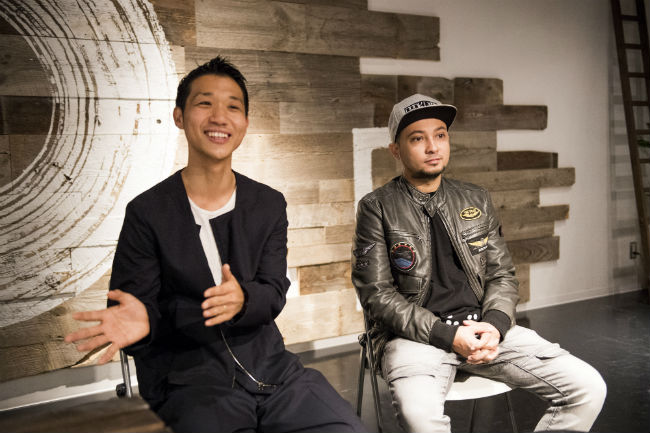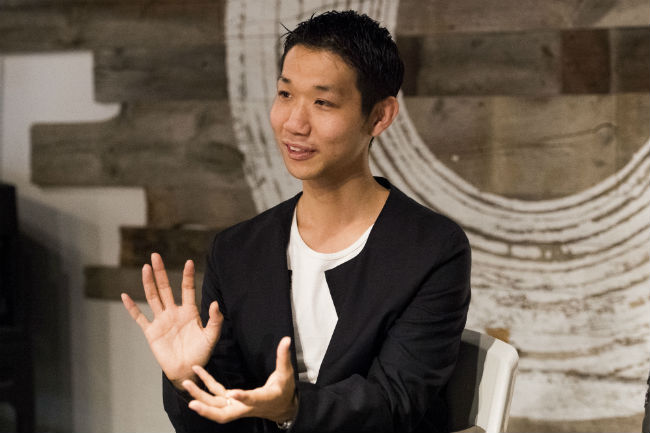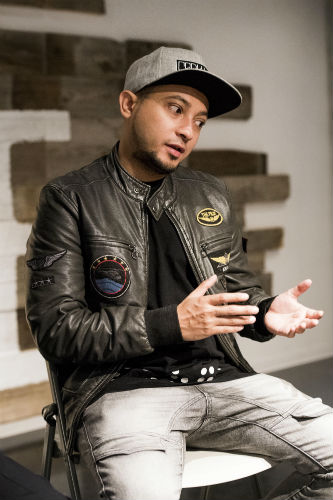
ASIA HUNDREDS is a series of interviews and conference presentations by professionals with whom the Japan Foundation Asia Center works through its many cultural projects.
By sharing the words of key figures in the arts and cultures in both English and Japanese and archiving the "present" moments of Asia, we hope to further generate cultural exchange within and among the regions.
Outside the studio-where it all started
Atsushi Kosugi (hereinafter Kosugi): Ozawa san, you are based in Shibuya and have been expanding your En Dance Studios*1 across Japan. Hamdi san, you manage Bboy Indonesia*2 and Fabas ART Dance Productions*3 in your country Indonesia, where you have been working to spread street dance among your people. You two are similar, in that you are both involved in the development of dancers that will lead the street dance scene of your respective countries. So today, perhaps you would like to talk about the current situation as well as the future outlook of street dance in Japan and Indonesia. First of all, could you tell us about your first encounter with street dance?
*1 "A dance studio that brings the world closer to you"
Widely acclaimed by dancers around the world, En Dance Studio has 8 branches in the Kanto area with professional dancers many of whom are active in Japan and on the international dance scene.
En Dance Studios
*2 Bboyindo is the first official organization for the street dance/Bboy community in Indonesia. Founded by Hamdi Fabas in 2003, Bboyindo is the hub of the Indonesian street dance scene. It works with the Ministry of Youth and Sports Affairs to generate more interest in street dance among the younger generation.
Bboyindo Official Website
*3 Fabas Art Dance Productions is a dance company based in Jakarta that specializes in performing arts, event management and creative consulting.
Fabas Art Dance Productions Facebook
Yusuke Ozawa (hereinafter Ozawa): I came across street dance 17 years ago when I was a high school student. At the time, there were no dance studios like "En", so we danced in parks and in front of glass buildings. I had easy access to a park where DJs, dancers and rappers would get together and practice to music, so it was through this environment that I first became interested in street dance. Since there was no one to teach us, we taught each other various dance moves by watching videos of "Dance Koshien*4 " from the TV program "Tensai Takeshi no Genki ga Deru Terebi!!" that was popular with the generation before us. Another dance show that we used to watch was called "RAVE 2001*5 ", where the MC was SAM from the Japanese pop group TRF.
*4 "Dance Koshien" is one of the popular projects of the variety show "Tensai Takeshi no Genki ga Deru Terebi!!"that was broadcast by the Nippon Television Network Corporation from 1985 to 1996. In this program, high school students from all over Japan battled with various styles of dance, especially street dance. This program made dance more popular among Japan's young generation.
*5 This is a dance contest program that has been broadcast since 1998 by the TV Tokyo Corporation.
Hamdi Fabas (hereinafter Fabas): I have a background in street dance, but when I was learning, street dance was not a big industry in Indonesia. Since modern dance and Broadway style were the mainstream, and street dance was regarded as something different, we had to take the initiative and develop street dance so that it would become a form of entertainment. Like Ozawa san, I started dancing outside the studio and was not involved in any business at the beginning. I think we are very similar in that way. I too learned through television and video recordings, because the internet environment was not as good as it is now.
Kosugi: Ozawa san, you went to America later on.
Ozawa: Two years after I had started dancing, I decided that I wanted to go to the U.S., the birthplace of street dance. I studied English and dance in Los Angeles for 4 years. At my dance school, there were many dancers from Europe and Asia as well. The first problem that I encountered was language, but I soon learned that nationality does not matter when it comes to dancing and sharing with one another. I sensed that there was a huge possibility in dance as a tool for non-verbal communication; that through dance, you could become friends with anyone. I wanted to help expand communities that were created through dance. Going to the U.S. also helped me to appreciate my own country Japan. My experiences of studying abroad have a big influence on what I do today.

Fabas: In my case, dance was a hobby at first. Street dancers were not seen as professionals, and I think it was this general perception that created a barrier for street dance to enter the entertainment world. It was very hard to communicate how powerful street dance is as a form of expression and to gain recognition from the general public. So in order to draw people's attention, we incorporated Michael Jackson-like pop moves such as the Moonwalk. I have an uncle who used to be a Bboy dancer, and I learned to dance from him as well. I think you could say that we, including my uncle, are the first generation of Bboy dancers in Indonesia.
We were very young and were able to make a fresh impression on the entertainment industry, so that is how we started our careers. I am sure we made them think, "Maybe these guys can do something new for us".
In those days, it was hard to get out of Indonesia, so I do not have the experience of going abroad to study like Ozawa san. Instead, we talked to our friends at the Cultural Center in our country and asked for their help to invite dancers from overseas to run workshops for us. This is the first time we ever experienced a studio environment. From then on, street dancers were gradually able to use studios. But even now, funding is still a problem whenever we want to start up a studio.
Ozawa: I see. In my case, I wanted to be involved in dance-related activities in my hometown Gunma. So I talked to members of my dance group, and I started teaching in local dance studios which already existed back then, even though there were not that many. But while I was teaching, I began to wonder, "Is this really the place where I can make good use of my experiences in the U.S.?". There was a strong feeling inside me telling me to express what I felt was important, which is what led me to create my own dance studio. I wanted to build a community of dancers with whom I could share my own values and work together. In 2008, after making a few presentations, we were allowed to use a studio inside a fitness center. This is how En Dance Studio started. We did not have very much money, but we were lucky because we were renting, and there was no need to invest in facilities.
Fabas: I see. That is a very interesting story.
Ozawa: I think the timing was good as well. In 2012, hip-hop dance became a compulsory subject in Japanese junior high schools, and it was around this time that the general public became more familiar with street dance through, for instance, music videos featuring dance like those produced by the Japanese dance and vocal group "EXILE". Although this is not the reason I set up my dance studio, I think I made a good move at the right time, since it was a period when street dance was beginning to move away from its negative image. Other factors such as easy access to dance videos on YouTube also helped.

The current state of dancers and studios in Indonesia and Japan
Kosugi: Could you tell us about the current Indonesian street dance scene and the dance industry in general?
Fabas: In Indonesia, street dance is so far considered to be something creative, so my feeling is that there are many situations where street dance can survive. The first thing that comes to mind is street dance as a form of entertainment. Here, the recreational aspect is highlighted while the educational side of street dance is somewhat overlooked. I feel that until now, street dance has been considered more as a type of competitive sport.
I think this is because street dance does have a competitive aspect, as you can see in dance battles. Since competition is a part of everyday life in the modern world, I believe that through street dance, people can learn how to adapt to competitive circumstances.
As far as government support is concerned, in Indonesia, street dance receives support from the Ministry of Youth and Sports Affairs. Although the Ministry of Education and Culture does not officially acknowledge street dance, it still provides us with support as necessary, such as issuing a school license when we build a studio.
Also, ballroom dance such as latin and salsa is very popular in Indonesia. Ballroom dance belongs to the Indonesian Dancesport Association and receives support from the Ministry of Youth and Sports Affairs.
So roughly speaking, street dance is considered to be a recreational sport, whereas other types of dance (ballroom dance) are recognized as a mainstream Olympic-style sport.
Even though the Ministry of Youth and Sports Affairs supports street dance, it considers street dance to be a recreational sport and separates it from ballroom dance which is categorized as a competitive sport.
Ozawa: So there is a difference?
Fabas: Yes. In Indonesia, we have just reached the stage of beginning to teach street dance in studios. Classes according to level of proficiency such as beginner, basic, intermediate and advanced have only just started. Having said so, managing studios is not always an easy task, because videos posted on internet sites are so popular these days.
Ozawa: In the case of En Dance Studio, in a way, we have been able to expand our business by using social media to spread information. In terms of business, the normal way would be to invest in marketing through printed media, but when we thought about how we could compete with other dance studios within a limited budget, we came up with the idea of maximizing the use of social media. Take, for example, our lesson videos that we post on the internet. By being just a little creative in our shooting, the videos have become more entertaining and enjoyable for the viewers.
Fabas: Hearing your story, it seems as though circumstances surrounding the street dance scenes in Japan and Indonesia are totally different. Ozawa san's way of using his weaknesses and converting them into strengths is very interesting, because in Indonesia, you hear a lot about the struggles of studio managers. In Jakarta, there are about 10 major studios, but it is very difficult to get people to enroll in classes. Although the minimum fee is high in comparison to the cost of living, if we take into consideration the rents and labor costs, it is imperative to maintain this minimum charge. The Indonesian economy is developing, and it is good news that people are now able to spend more money on recreation. Having said so, leisure is still not given top priority in people's lives, so they might think, "We can just watch these internet videos and learn how to dance" and may not feel motivated to take real lessons in the studio.
Ozawa: Personally, I think that the Japanese people just love to learn and take classes, which is possibly why it is easier to run dance schools than it is in Indonesia.
Kosugi: You mean that dance is considered as one of the many out-of-school activities for Japanese children?
Ozawa: Yes. So they tend to dance seriously, following the teacher's example. In American studios, a lot of people just danced freely even in the presence of a teacher. Also in Japan, people have a strong desire to learn a skill that is properly categorized, such as the "standard" or "classic" hip-hop dance.
Fabas: The Indonesian people love to learn as well, and I think it is important that learning happens in a fun environment under no pressure. I too have the experience of teaching at a fitness center, where many people came to my class just wanting to "have fun with street dance". Once you pay a one-time fee to become a member of the fitness center, you can take any class you like, which I think may be the reason behind the popularity of fitness centers as a place to learn. So if I were to open a studio of my own, I would charge a one-time fee and let students choose any classes they like. Of course, I would have to do some serious calculations to make sure that I do not go into the red!
Ozawa: That is very important! Also, it is said that Japanese people are not satisfied unless they dance "well". Whatever skill that interests them needs to be mastered with precision, just like a craftsman masters his trade. I also think that because they are shy, the Japanese tend to work on their dance techniques and build confidence to cover their shyness.
Fabas: In Indonesia as well, there are many dancers who push deep into the different genres of dance. It is something that we did not see before; a trend that has become prominent in recent years. It is probably influenced by the fact that dancers are now able to go overseas. For Indonesian dancers, Singapore is the closest foreign country where they can upgrade their dance skills. So many of us have gone to Singapore and have had the opportunity to meet Japanese dancers among others at festivals and dance contests. Some people have managed to build a teacher and student relationship with Japanese dancers, and I think there are now more Indonesians who want to deepen their skills by learning from the Japanese trend that Ozawa san has just been talking about.

Kosugi: I heard that at En Dance Studio, you are also enthusiastic about accepting participants from overseas.
Ozawa: Yes. For example, in the past we have invited Beyonce's backup dancers as instructors, and for our summer dance camp, we invite about 8 to 10 famous dancers from overseas and organize a weeklong course for 200 participants. Events such as these and the influence of social media have helped attract students from countries outside Japan. As I mentioned at the beginning, for my generation, America was the place to be when it came to dance, but nowadays, people are coming to Japan to learn how to dance. From Asia, we have participants from China, Thailand, Korea, Indonesia, Malaysia and Singapore. From Europe, students come from France, Spain, the U.K., Sweden...and the list goes on. Those who have seen our internet videos are wondering, "Why are the Japanese so good?" and are now coming here to learn from us. Also, there are some dance instructors who have trained here and have later on gone to Europe and other countries to teach. It seems that they are the ones who have spread the word that "there are good dancers in Japan and you can improve your skills by going to Japan". The basic class is especially popular. The Japanese recognize the importance of learning the basics, and there is a trend among overseas dancers to come here to specifically learn the basics skills of dance. When you look behind the high level of technique displayed by Japanese dancers, you find that there is a strong foundation of basics, and people seem to know about this. Another influence may be the fact that more Japanese dancers are enjoying success outside Japan. Dancers such as Koharu Sugawara, s**t kingz and TOKYO GEGEGAY are now active overseas as well.






